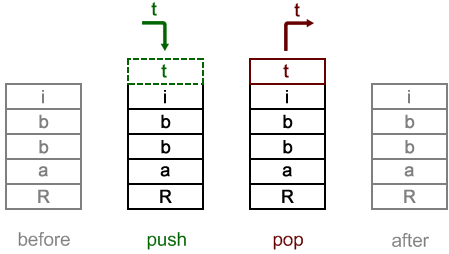Stack
Stack is one of the fundamental data structures in computer science and it is used in many algorithms and applications. As an example, stack is used:
- implicitly in recursion;
- for expression evaluation;
- to check the correctness of parentheses sequence;
- etc.
Stack ADT
Well illustration from the real world is a stack of books, where you can operate with a "top" of the stack only. We will dedicate six operations on the stack. You can put a book on top (push); look, which one lays on top of a stack (peek) and remove a topmost book (pop) and check, if stack is empty (isEmpty). Also, there are two operations to create and to destroy a stack. Let us structure them up in the following list.
Operations
- Stack create()
creates empty stack
- boolean isEmpty(Stack s)
tells whether the stack s is empty
- push(Stack s, Item e)
put e on top of the stack s
- Item peek(Stack s)
returns topmost element in stack s
Precondition: s is not empty
- pop(Stack s)
removes topmost element from the stack s
Precondition: s is not empty
- destroy(Stack s)
destroys stack s
Note. In different sources peek operation may be called top.
Axioms
- newly created stack is empty;
- after pushing an item to a newly created stack, it becomes nonempty;
- peek returns the most recently pushed item;
- stack remains untouched, after a pair of push and pop commands, executed one after another.
Example
Sketchy, stack can be shown like this:

Implementations
We are going to discuss two implementations of the Stack ADT. Each of them has it's own advantages and disadvantages, which are examined in the articles below:
- array-based stack implementation;
- linked list based stack implementation.
Visualizers
Recommended books
- Cormen, Leiserson, Rivest. Introduction to algorithms. (Theory)
- Aho, Ullman, Hopcroft. Data Structures and Algorithms. (Theory)
- Robert Lafore. Data Structures and Algorithms in Java. (Practice)
- Mark Allen Weiss. Data Structures and Problem Solving Using C++. (Practice)

 |
Contribute to AlgoList
Liked this tutorial? Please, consider making a donation. Contribute to help us keep sharing free knowledge and write new tutorials.
Every dollar helps!